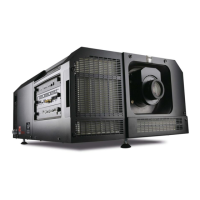6. Input & Communication
The connec tors used for all E therne t ports are of the type R J45, which is comp atible w ith standard RJ45 cable
connector. S traight (most common ) as well as cross linked network cables can be used. The 2 ports are
functionally identical. Bo th ports are co nnected via the projector switch (Auto sensing enabled).
Virtual comport (RS232 serial communication)
The USB -IN p ort of the com munication interface supports RS232 ser ial comm unication. You can use the RS232 input port to connect
a local PC to the projector. This w a y y ou can configure and control the projector from your loca l PC.
Do not forget to set the projector’s bau d rate (default = 115 200) to match that of the computer.
Advantages of using RS232 serial communication:
• easy adjustment of the pr ojector via PC (or MAC).
• wide range of control possibilities.
• sending data to the projector (update).
• copying data from the projector (backup).
RS232
An Electronic Industries A ssoc iation (EIA) serial digital interface standard spec ifying the characteristics of the comm u-
nication path between two devices using either D-SUB 9 pins or D-SUB 25 pins connectors. Th is standard is used for
relatively short-range communications and do es no t specify balanced control lines. RS-232 is a se rial control s tandard
with a s et number of cond uctors, data rate, word length and type of connector to b e use d. T he standard specifies com -
ponent connection standards with regard to computer interface. It is also called RS-232-C, which is the third version
of the RS -232 standard, and is functionally identical to the CCITT V.24 standard. Logical ’0’ is > + 3V, Logical ’1’ is < -
3V. The range between -3V and +3V is the transition zone.
52 R5906847 DP2K SLP SERIES 02/06/2017

